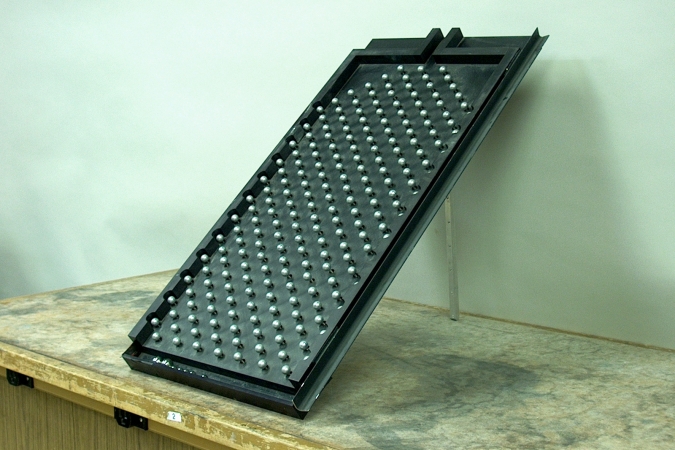

This apparatus consists of a matrix of aluminum balls mounted on springs, which represent the nuclei of atoms in a metal lattice. Along one side of the apparatus (at right in the photograph) runs a straight vee groove. The unit stands at a 40° incline. The steel balls resting in the track at the bottom represent electrons. When you release simultaneously a ball from the top of the vee groove and one from the top of the channel above the matrix of balls on springs, the one in the vee groove rolls down quickly, essentially with gravity (its component at 40°), but the one rolling through the apparatus is greatly slowed down by collisions with the various balls on springs.
Gravity pulling the balls down the incline represents a potential difference between the ends of a wire pushing electrons from one end to the other, and the scattering of the balls coming down the incline by the balls on springs represents the scattering of electrons by the ions in a metal lattice. In that electrons traveling through a metal lattice are scattered in a similar way, and since the periodic potential they experience as they move through the lattice affects their motion, this device is useful for showing the origins of electrical resistance in metals. In addition, the residual motion of the balls on springs after the descending ball has collided with them represents the process whereby electrons moving through a metal lattice transfer some of their energy to the lattice, causing vibrational excitation and the dissipation of this energy as heat.
It is important to note, however, that current flow, which is essentially the transfer of energy among electrons from one end of the wire to the other, occurs at nearly the speed of light (see demonstration 76.18 -- Speed of signal through coaxial cable), but the actual drift velocity of the electrons as they travel through the lattice is quite slow, typically on the order of several hundredths or thousandths of a centimeter per second, depending on the current density. For current flowing in a wire of length l and cross-sectional area A, the number of conduction electrons is nAl, where n is the number of conduction electrons per unit volume. This corresponds to a charge of q = (nAl)e, and the time it takes to pass through the wire is t = l/vd, where vd is the drift velocity. The current, i, equals q/t = (nAle)/(l/vd) = nAevd. Rearranging this gives vd = i/(nAe). Since j, the current density, equals i/A, this gives vd = j/ne. As an example, we can take a copper wire having a cross-section of 1.77 × 10-2 cm2 (1.5-mm diameter) carrying a current of 1 A, for a current density, j = 56.6 A/cm2. To get n, the number of conduction electrons per unit volume, we have n = dN0/M, or [(9.0 g/cm3)(6.022 × 1023 atoms/mol)(1 electron/atom)]/(64 g/mol) = 8.5 × 1022 electrons/cm3. Putting these values into vd = j/ne gives vd = (56.6 A/cm2)/[(8.5 × 1022 electrons/cm3)(1.6 × 10-19 C/electron)] = 4.2 × 10-3 cm/s. So while the demonstration accurately portrays the interaction of an electron with the ionic lattice as it travels through a metal, the motion it portrays is not exactly the same as the overall current flow.
References:
1) Eisberg, Robert and Resnick, Robert. Quantum Physics of Atoms, Molecules, Solids, Nuclei and Particles (New York: John Wiley and Sons, Inc., 1974), Chapter 13, mainly section 13-6, pp. 497-501.
2) David Halliday and Robert Resnick. Physics, Part Two, Third Edition (New York: John Wiley and Sons, Inc., 1978), pp. 675-678.